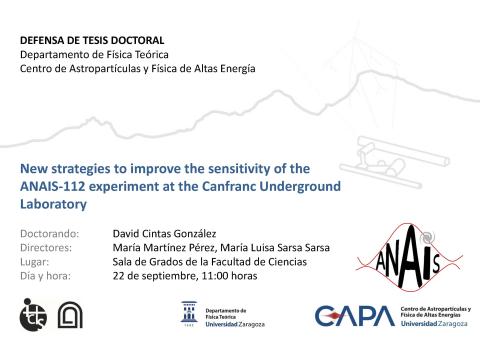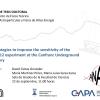Tesis doctoral. David Cintas González

TESIS DOCTORAL
New strategies to improve the sensitivity of the ANAIS-112 experiment at the Canfranc Underground Laboratory
Cintas González, David
Sala de Grados de la Facultad de Ciencias,
Viernes 22 de septiembre, 11:00 horas
SUMMARY:
Numerous astronomical and cosmological observations point to the existence of Dark Matter, which constitutes 26% of the mass-energy density of the universe. Since its nature is still unknown, its detection is currently one of the most important challenges in physics. Despite the intense experimental effort to detect this matter, only the DAMA/LIBRA experiment has observed an annual modulation in its detection rate consistent with the signal that would be produced by dark matter particles distributed in the galactic halo following the most standard model. To test the DAMA/LIBRA result independently of the dark matter model, it is necessary to use the same target material, and this is the goal of the ANAIS-112 experiment, which is taking data since August 3, 2017 at the Canfranc Underground Laboratory.
In parallel to the ANAIS-112 data acquisition, several complementary lines of research have been followed in this work with the aim of improving the sensitivity of the experiment.
The light emission response of NaI(Tl) crystals to sodium and iodine nuclear recoils has been analyzed. The so-called Quenching Factor (QF) is a key factor in the comparison between experiments. In this study, QF values have been determined for iodine and sodium nuclear recoils in different crystals, for the first time in the same setup and using the same analysis protocol, obtaining compatible values for all of them and identifying and quantifying the main sources of systematic error present in previous analyses. In particular the calibration method in electron equivalent energy has proved to be critical and allows understanding the discrepancies between previous measurements.
A GEANT4 simulation of an ANAIS-112 module has been developed including the optical processes of light emission and propagation after an energy deposit. This is the first step in an effort to understand the origin of some of the spurious event populations observed in the experiment.
Finally, the possibility of improving the sensitivity of NaI scintillators applied to the search for Dark Matter by replacing Photomultiplier Tubes with Silicon Photomultipliers (SiPMs) as light sensors has been studied. SiPMs offer very interesting opportunities within the new project ANAIS+. In this work we have characterized SiPMs from different manufacturers, established measurement protocols for the most relevant parameters, studied the properties of NaI and NaI(Tl) crystals at different temperatures and designed a NaI+SiPM prototype that will allow to evaluate limitations and opportunities of this new technology.

